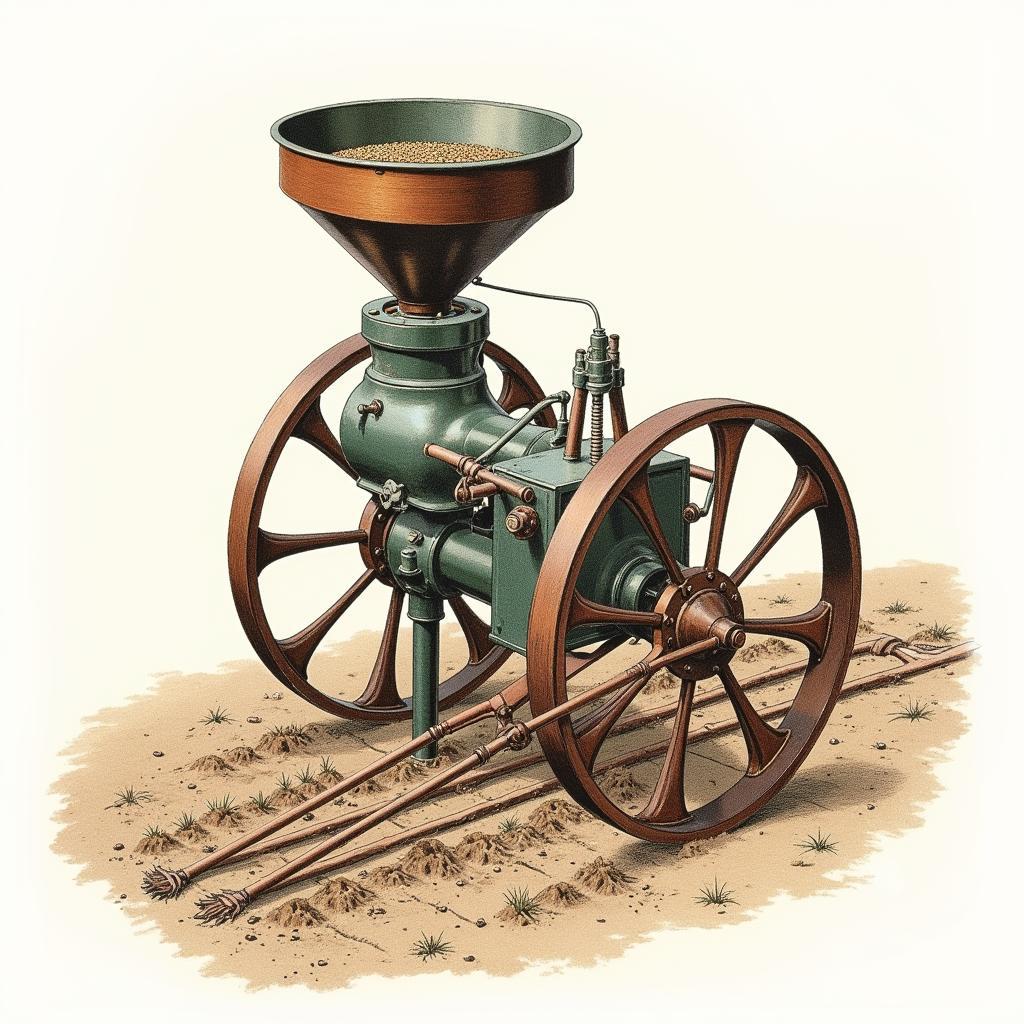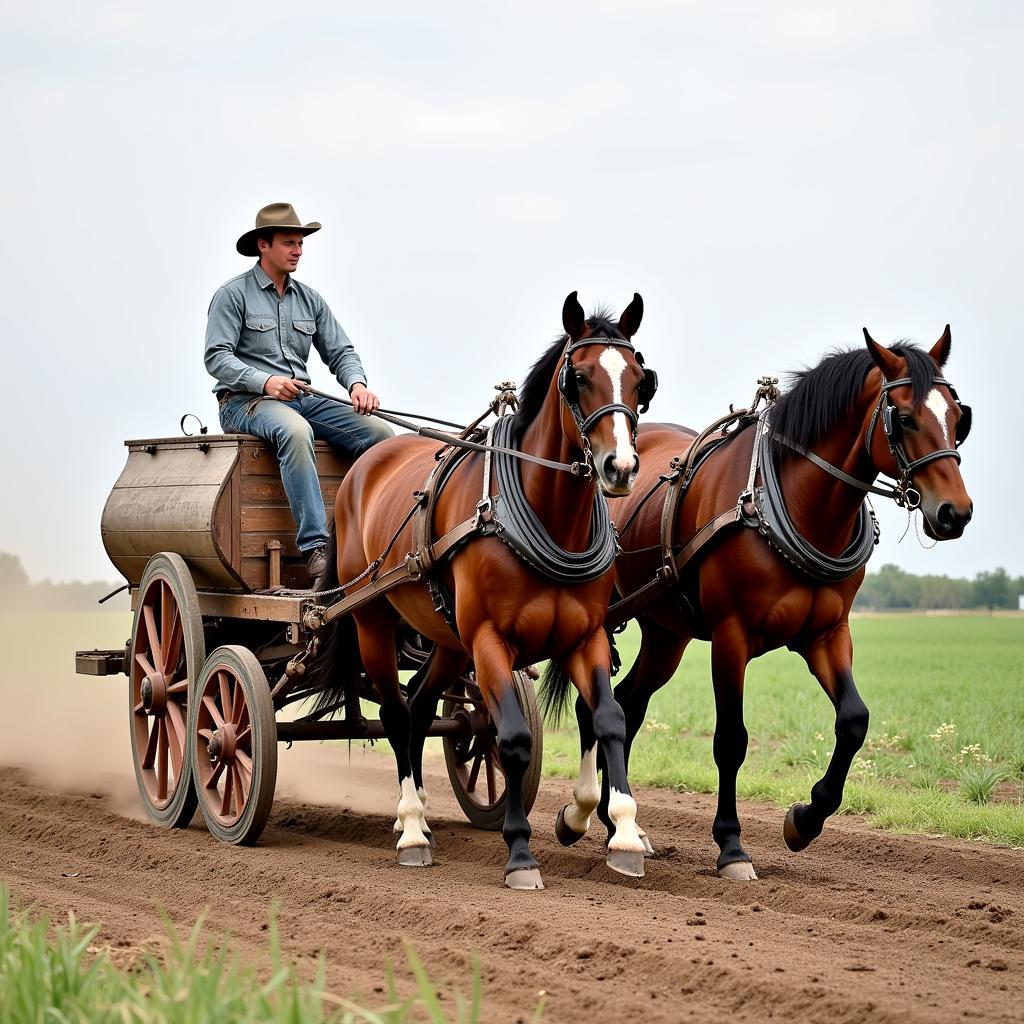The Antique Horse Drawn Seed Planter, a relic of a bygone era, offers a fascinating glimpse into the history of agriculture. These ingenious machines, once commonplace in fields across the country, represent a significant step forward in farming technology, bridging the gap between manual sowing and modern mechanized planting.
The Mechanics of the Antique Horse Drawn Seed Planter
These planters weren’t just simple contraptions; they were cleverly designed to automate the seed sowing process. A key feature was the seed hopper, which held the seeds ready for distribution. Beneath the hopper, a series of carefully spaced tubes or chutes directed the seeds into the furrows created by a plow attached to the front of the planter.  Antique Horse Drawn Seed Planter Mechanism: Detailed view of the seed hopper, distribution tubes, and furrow-creating plow. The planter’s wheels, often large and iron-rimmed, not only provided mobility but also powered the seeding mechanism through a series of gears and chains. This allowed for a consistent planting depth and spacing, crucial for optimal germination and growth. Different models catered to various seed types and row spacing requirements, showcasing the adaptability of these early agricultural innovations.
Antique Horse Drawn Seed Planter Mechanism: Detailed view of the seed hopper, distribution tubes, and furrow-creating plow. The planter’s wheels, often large and iron-rimmed, not only provided mobility but also powered the seeding mechanism through a series of gears and chains. This allowed for a consistent planting depth and spacing, crucial for optimal germination and growth. Different models catered to various seed types and row spacing requirements, showcasing the adaptability of these early agricultural innovations.
The Evolution of Planting: From Hand Sowing to Horse-Drawn Efficiency
Before the advent of the antique horse drawn seed planter, farmers relied on the laborious process of hand sowing. This involved scattering seeds by hand, a time-consuming and often uneven method. The introduction of horse-drawn planters revolutionized farming.  Horse Drawn Seed Planter in Field: A farmer operating a horse-drawn seed planter in a field, demonstrating the historical context of this technology. Farmers could cover significantly larger areas in less time, resulting in increased yields and greater efficiency. The horse, a reliable and readily available power source, played a pivotal role in this agricultural transformation.
Horse Drawn Seed Planter in Field: A farmer operating a horse-drawn seed planter in a field, demonstrating the historical context of this technology. Farmers could cover significantly larger areas in less time, resulting in increased yields and greater efficiency. The horse, a reliable and readily available power source, played a pivotal role in this agricultural transformation.
Collecting and Restoring Antique Horse Drawn Seed Planters
Antique horse drawn seed planters are highly sought-after by collectors and history enthusiasts. These machines represent a tangible connection to agricultural heritage, a reminder of the ingenuity and hard work that shaped the farming landscape. Finding and restoring these planters can be a rewarding experience. Many collectors scour antique shops, auctions, and online marketplaces to unearth these hidden gems. Restoration often involves meticulous cleaning, repair, and replacement of worn-out parts. The end result is a beautifully preserved piece of history, a testament to the craftsmanship of a bygone era.
“Restoring an antique seed planter is like bringing a piece of history back to life,” says Johnathan Miller, an agricultural historian and restoration expert. “It’s a rewarding process that connects you to the ingenuity of past generations.”
“These machines are not just relics; they’re a testament to the evolution of agriculture,” adds Sarah Jenkins, curator of the Agricultural Heritage Museum. “They tell a story of innovation and adaptation, showcasing the crucial role of technology in shaping our food production systems.”
In conclusion, the antique horse drawn seed planter stands as a symbol of agricultural progress. From its ingenious mechanics to its impact on farming practices, this piece of history offers a fascinating glimpse into the past. Whether you’re a collector, historian, or simply curious about the roots of modern agriculture, the antique horse drawn seed planter is a testament to human ingenuity and the enduring connection between humans, animals, and the land.
FAQ
- What is the purpose of an antique horse drawn seed planter? To efficiently sow seeds into the ground for planting.
- How does a horse drawn seed planter work? The planter’s wheels power a mechanism that distributes seeds through tubes into furrows created by a plow.
- Where can I find antique horse drawn seed planters? Antique shops, auctions, and online marketplaces.
- What is involved in restoring an antique seed planter? Cleaning, repairing, and replacing worn-out parts.
- Why are antique seed planters valuable? They represent a tangible connection to agricultural history and the evolution of farming technology.
- What types of seeds could be planted with these machines? Various seed types, depending on the model and its configuration.
- How did these planters impact agriculture? They significantly increased efficiency and yields compared to hand sowing.
Looking for more information about horses and other aspects of farming history? Explore our other articles on Justus Horses USA!
Need assistance? Contact us 24/7: Phone: 0772127271, Email: [email protected] or visit us at QGM2+WX2, Vị Trung, Vị Thuỷ, Hậu Giang, Việt Nam.